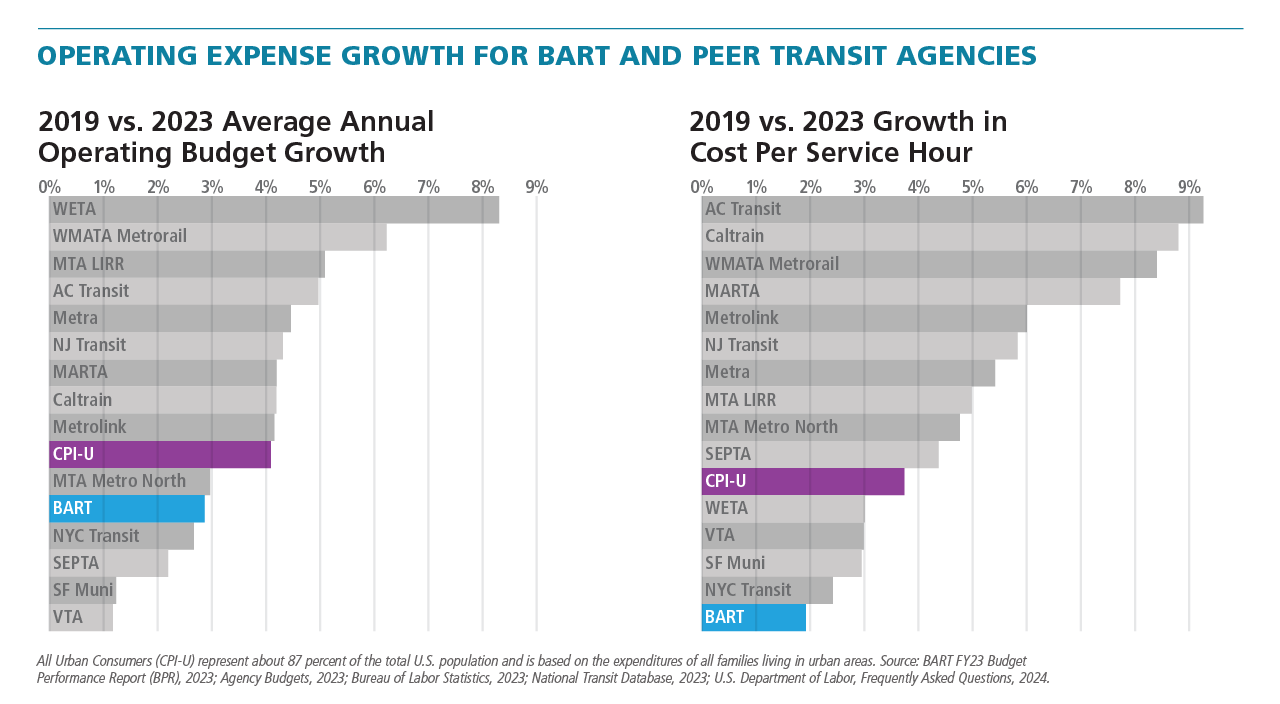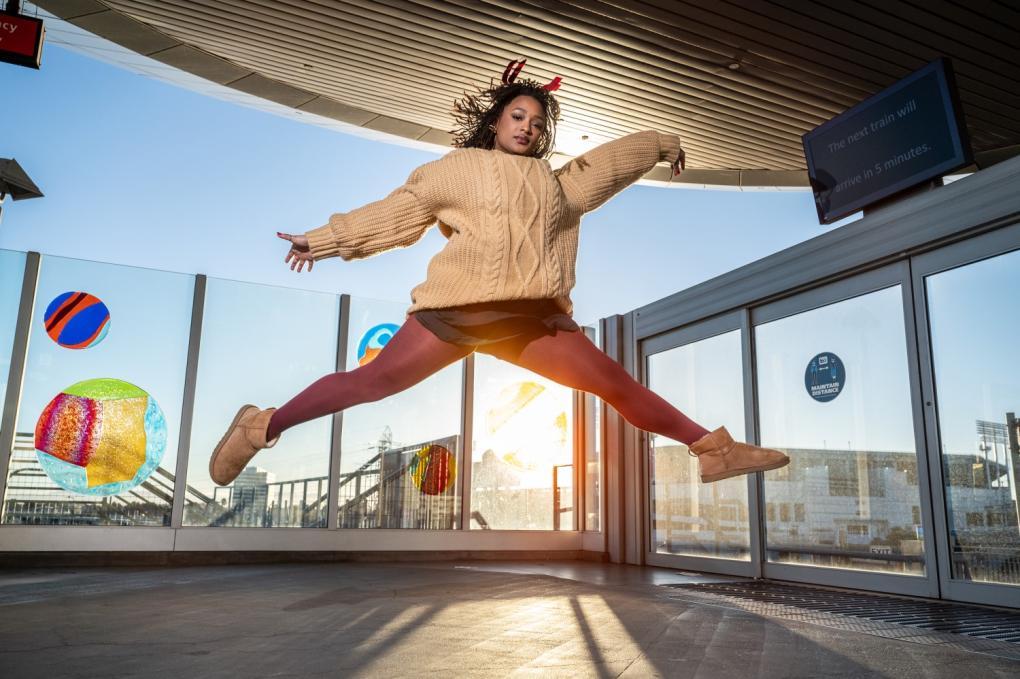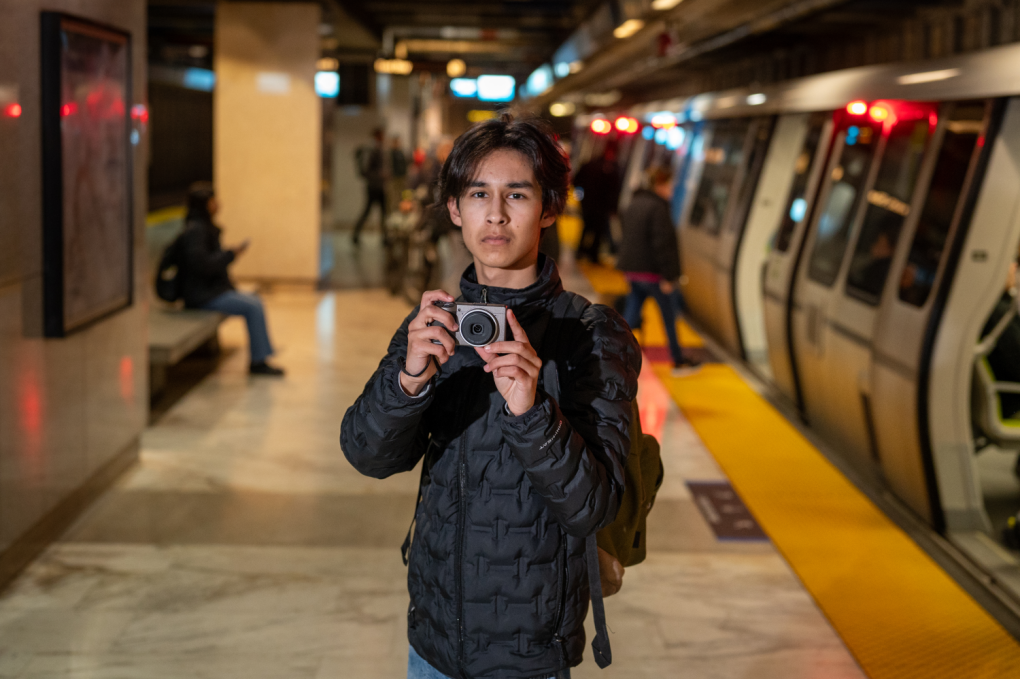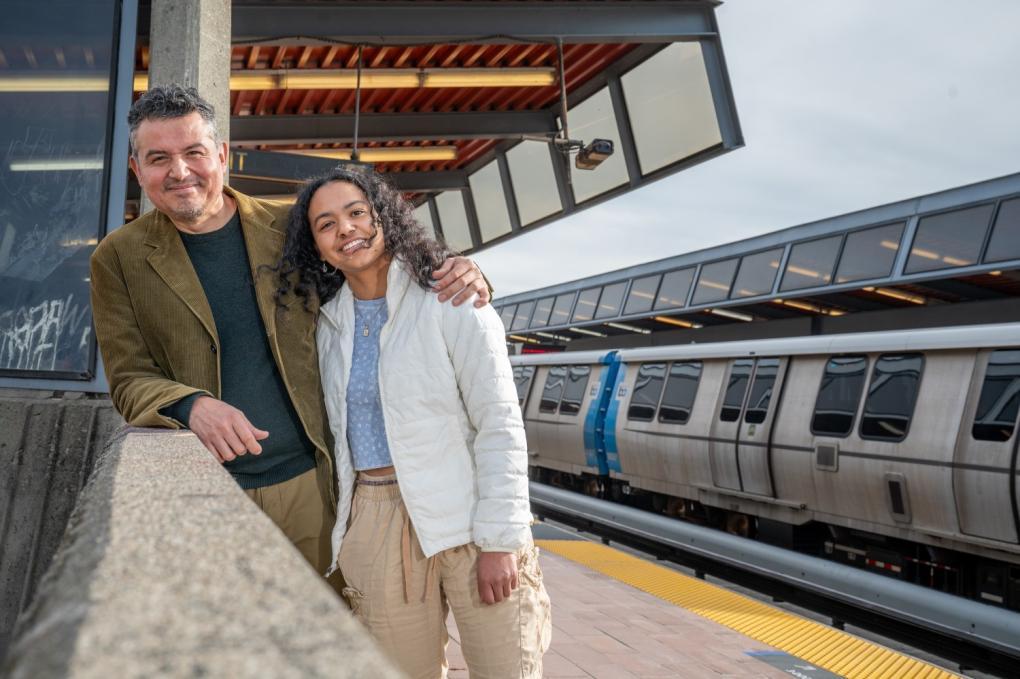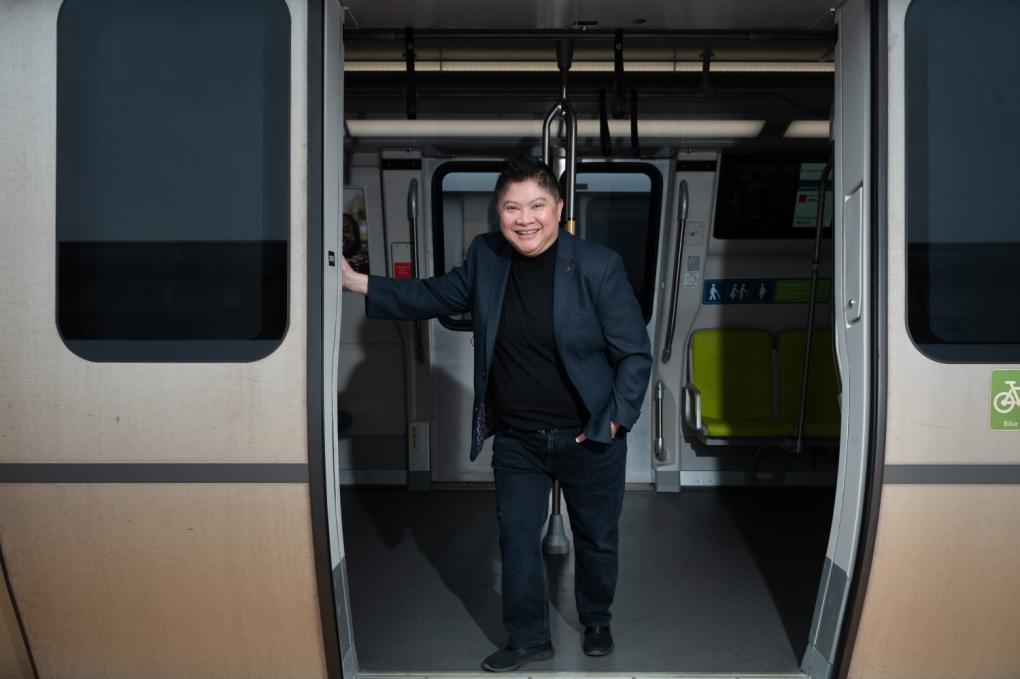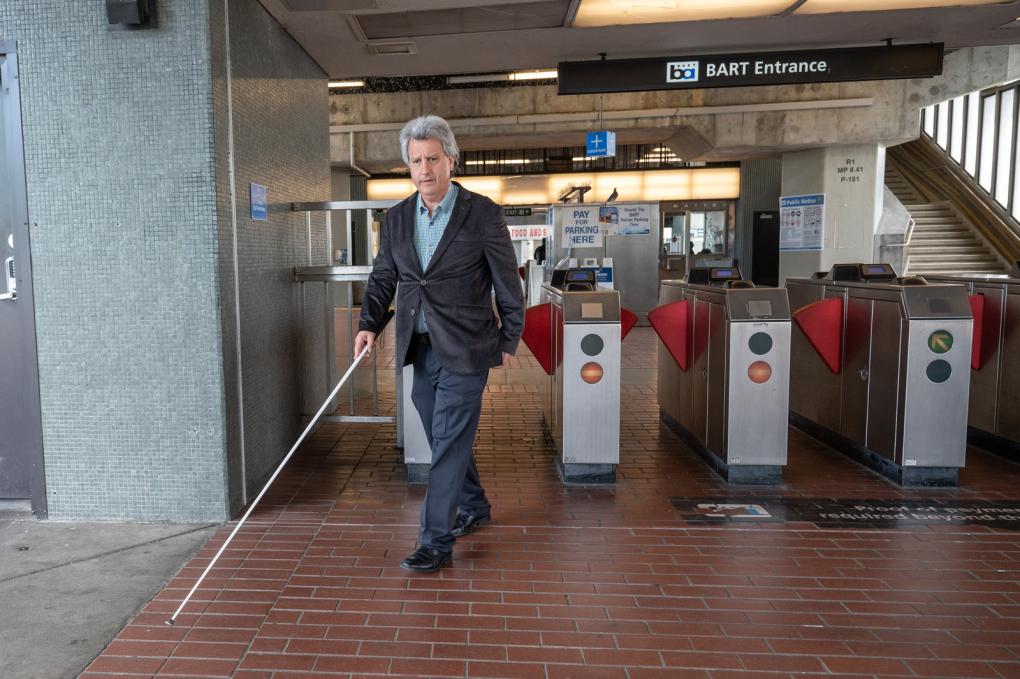
For more than 50 years, BART has served as the Bay Area’s regional connector. By providing excellent rail service to riders of all backgrounds and abilities, this system has long been a central component in the region’s mobility, cultural diversity, environmental and economic sustainability.
The Role in the Region Study provides insights into emerging trends and outlines BART’s benefits to the Bay Area, highlighting BART’s essential role in the region’s success and the well-being and quality of life of those who reside and travel here.
You can view the full report by clicking on the image below or check out some of the key findings when you scroll down this page. References and sources for the findings below are available in the report pdf.

BART's Role in the Region Study (pdf)
BART is publishing a series of explainer articles that dive into some of the subjects explored in Role in the Region. Click here to read the first story -- on BART's role in reducing regional traffic -- click here for the second story, which explores BART's contributions to the economy, here for an explanation on how BART lowers cost of living in the Bay Area, and here for a breakdown of BART's importance to regional sustainability.
Highlights from the Report :
Click on a topic below to jump to that section.
I. Travel and Funding Changes
A. Remote Work’s Impact on Ridership
B. Adapting to Changing Regional Travel Trends
C. The Need for a New Funding Model
II. BART’s Benefits
A. Reducing Regional Travel and Housing Costs
C. Without BART, Traffic Congestion Would Worsen
D. BART Connects People to Destinations and Experiences that Matter
E. BART’s Contributions to Economic Growth
F. Protecting Health, Climate, and Resilience
III. The Future of BART
A. The Consequences of No BART Service
B. BART’s Stewardship of Public Resources
IV. BART Connects - Rider Stories
I. Travel and Funding Changes
BART is adapting to changes in travel and the funding landscape following the COVID-19 pandemic that upended longtime ridership trends and turned BART’s funding model on its head.
A. Remote Work's Impact on Ridership
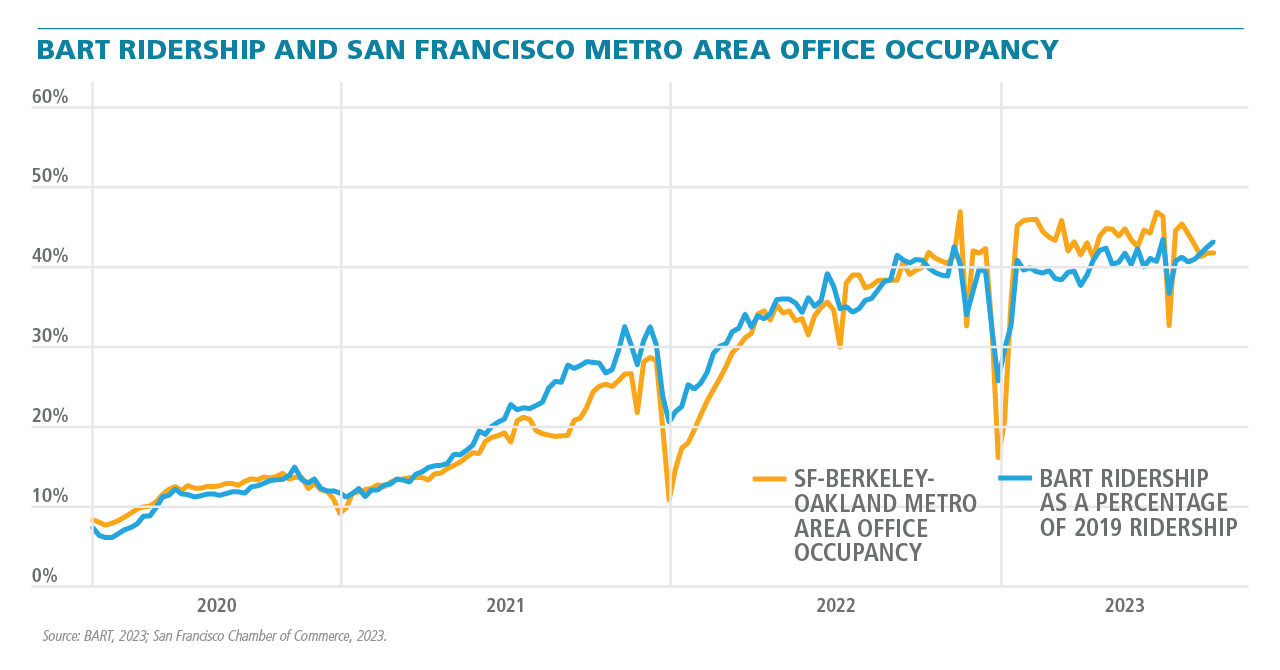
Remote work has fundamentally changed how the region travels, and BART ridership is closely linked to regional office occupancy rates as shown in the above graph. Riders are taking fewer trips than they did prior to the pandemic. Comparing October 2023 with October 2019, the number of unique BART riders has recovered by 72%, whereas total trips have only recovered by 43%.
B. Adapting to Changing Regional Travel Trends
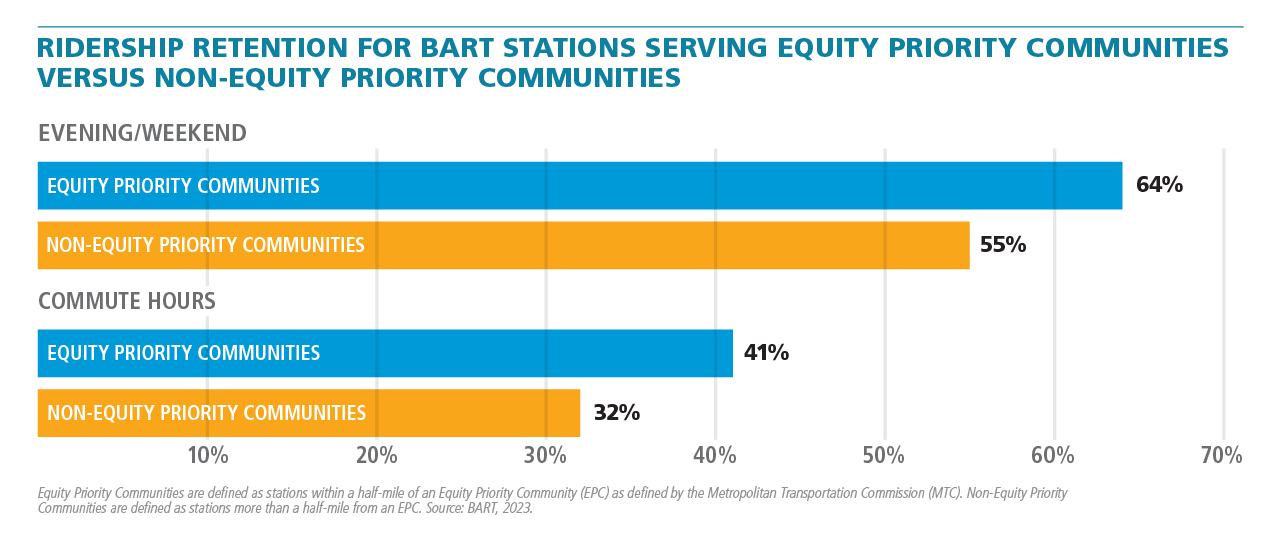
Changes in regional travel have also resulted in new ridership trends. Work trips now make up a smaller share of all trips, and riders are using the system more frequently for personal needs. Evening, weekend, and airport service have also retained ridership more strongly than commuting. BART stations serving equity-priority communities also have higher rates of ridership recovery compared to stations serving non-equity priority communities, as demonstrated in the graph above. BART has adapted service to meet new travel trends, including boosting evening and weekend service by up to 50% starting September 2023.
C. The Need for a New Funding Model

BART needs a sustainable, long-term funding model to continue effectively serving the Bay Area's needs. Before the pandemic, BART covered about 60 percent of its operating costs through passenger fares, relying very little on financial assistance from regional, state, and federal government compared to peer agencies (see graph). If BART’s forecasted deficit were filled with financial assistance, it would bring BART closer to the national average. Note that the sources for the graph above are 2019 National Transit Database (NTD) and BART internal data. According to NTD, BART has a 70% farebox recovery. BART's internal data includes expense categories not included by NTD.
II. BART's Benefits
BART benefits everyone in the Bay Area, whether they use transit or not. The system alleviates already-choked roadways; contributes billions to the economy; lowers the cost of living; helps the state and region meet housing and sustainability goals; and supports the overall health, safety, and resiliency of the Bay Area.
A. Reducing Regional Travel and Housing Costs
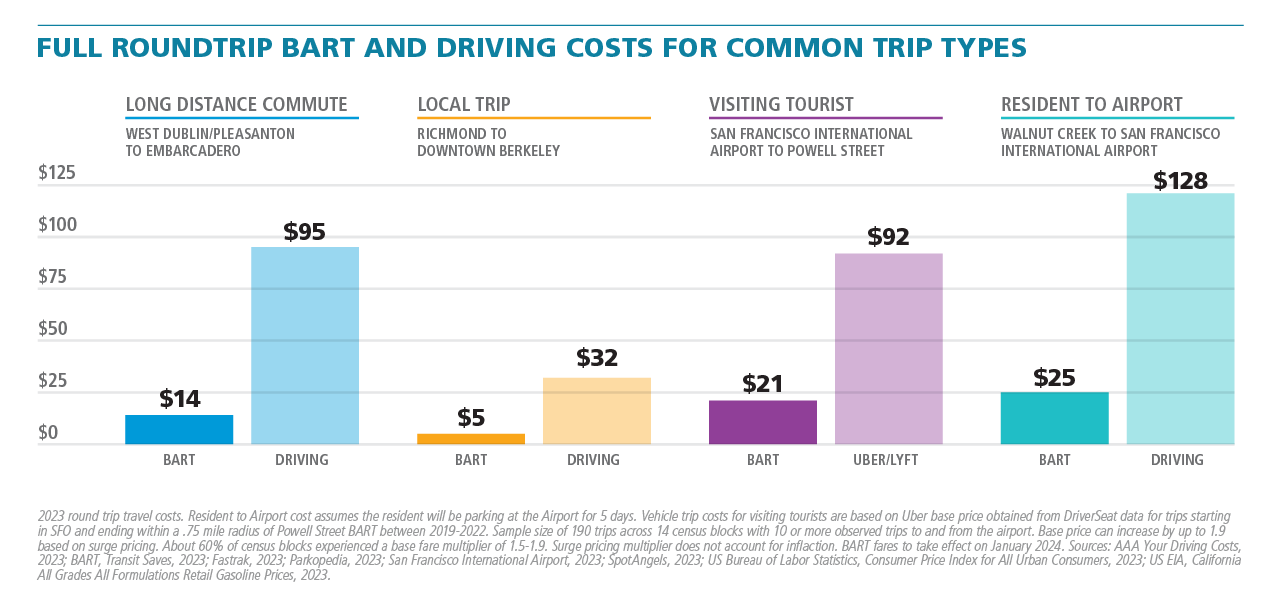
BART is an affordable mode of transportation that is especially vital for the people who need it most. BART is significantly more affordable than driving, as shown in the graph above.
BART also helps the state and the region meet housing goals. The majority of existing and under-construction affordable housing in the region is located near BART and other regional rail. BART’s Transit-Oriented Development (TOD) Program also has the ambitious goal of constructing 8,000 housing units near stations; 35% of which would be designated as affordable housing.
B. BART is Fast and Reliable
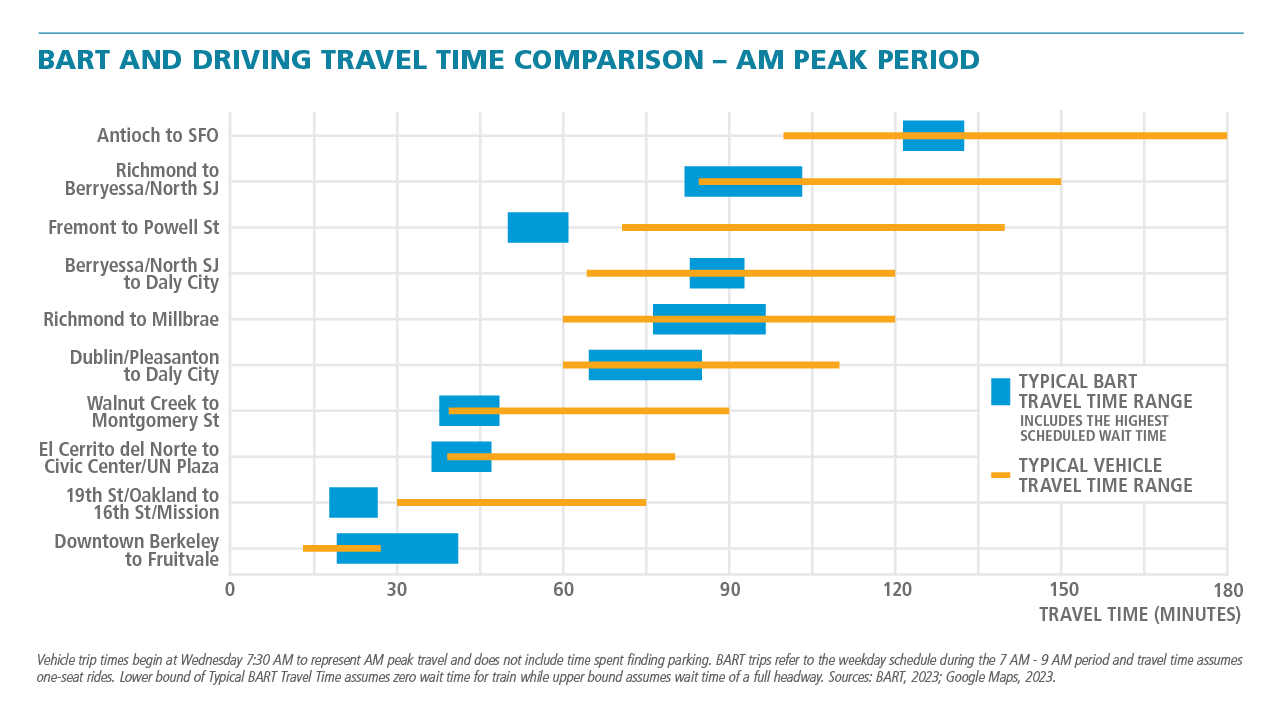
For many regional trips, BART is faster, safer, and more reliable than driving. BART travel time ranges are narrower, meaning people don’t have to build in as much buffer for their trips compared to driving.
C. Without BART, Traffic Congestion Would Worsen
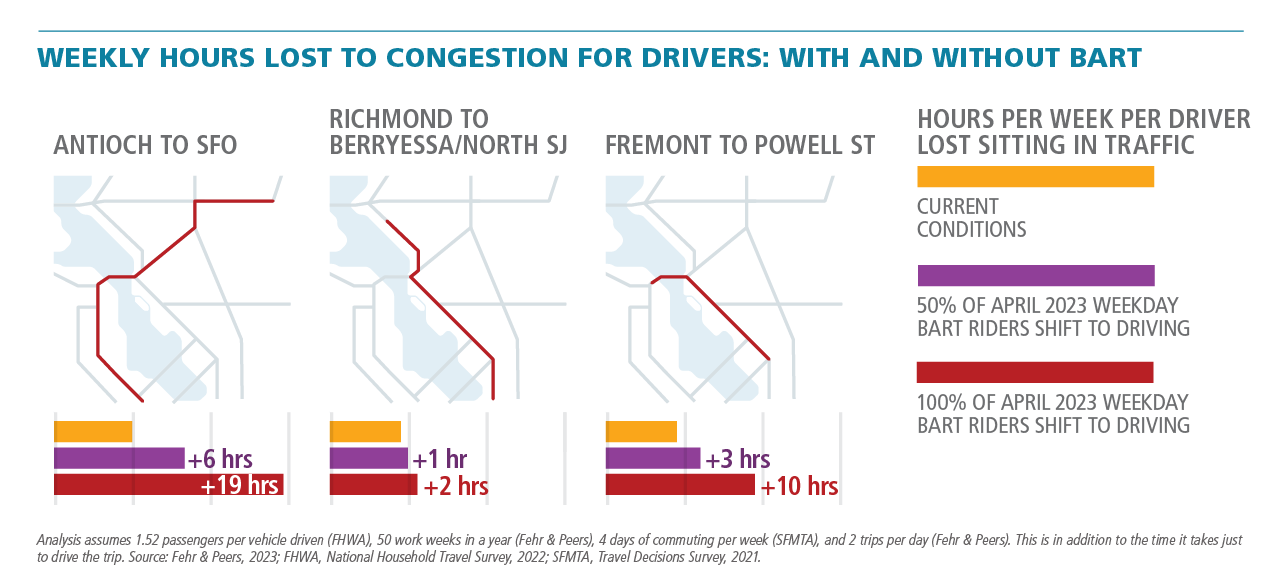
BART service even benefits residents that choose to drive, in part by significantly reducing their time lost to congestion and thereby improving quality of life for everyone who lives here, whether they use transit or not. As shown in the image above, if BART did not exist, for some trips drivers could experience upwards of 19 hours in congestion weekly, in addition to the time it would take without any traffic.
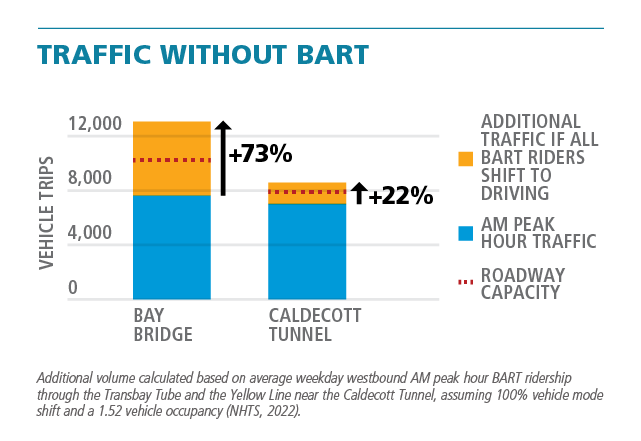
If BART ceased to exist and riders had to drive instead, traffic could increase by 73% on the Bay Bridge and 22% in the Caldecott Tunnel during morning peak commute hours, which would exceed roadway capacity. To support the increased traffic volume, up to three additional lanes would need to be added to the Bay Bridge and an additional lane in the Caldecott Tunnel.
D. BART Connects People to Destinations and Experiences that Matter

Twenty-one percent of the region’s jobs and 9% of the 9-county Bay Area region’s residents (665,000 people) are within a 15-minute walk from a BART station. This coverage expands when one takes into consideration connecting regional transit services, such as SF Muni and AC Transit. Within a 15-minute walk of local transit stops that can be reached with one transfer, there are 67% of the 9-county Bay Area region’s jobs (2.5 million), 61% of the region’s residents (4.6 million), and 60% of (3,400) regional schools, parks, and libraries.
E. BART’s Contributions to Economic Growth

In 2023, BART contributed $1.2 billion to the economy through more than 5,000 jobs, and between 2019 to 2023, BART infused more than $3.7 billion associated with construction spending and $1.7 billion in construction labor income into the economy.
BART also supports the recovery of downtowns and the continued growth of the East Bay. In Downtown San Francisco, for example, the 15 “trophy” office buildings – buildings with the highest rents and lowest vacancy rates – are all within a 15-minute walk from BART’s Embarcadero and Montgomery stations. This includes the Transamerica Building, Salesforce Tower, and the Ferry Building, among others.
F. Protecting Health, Climate, and Resilience
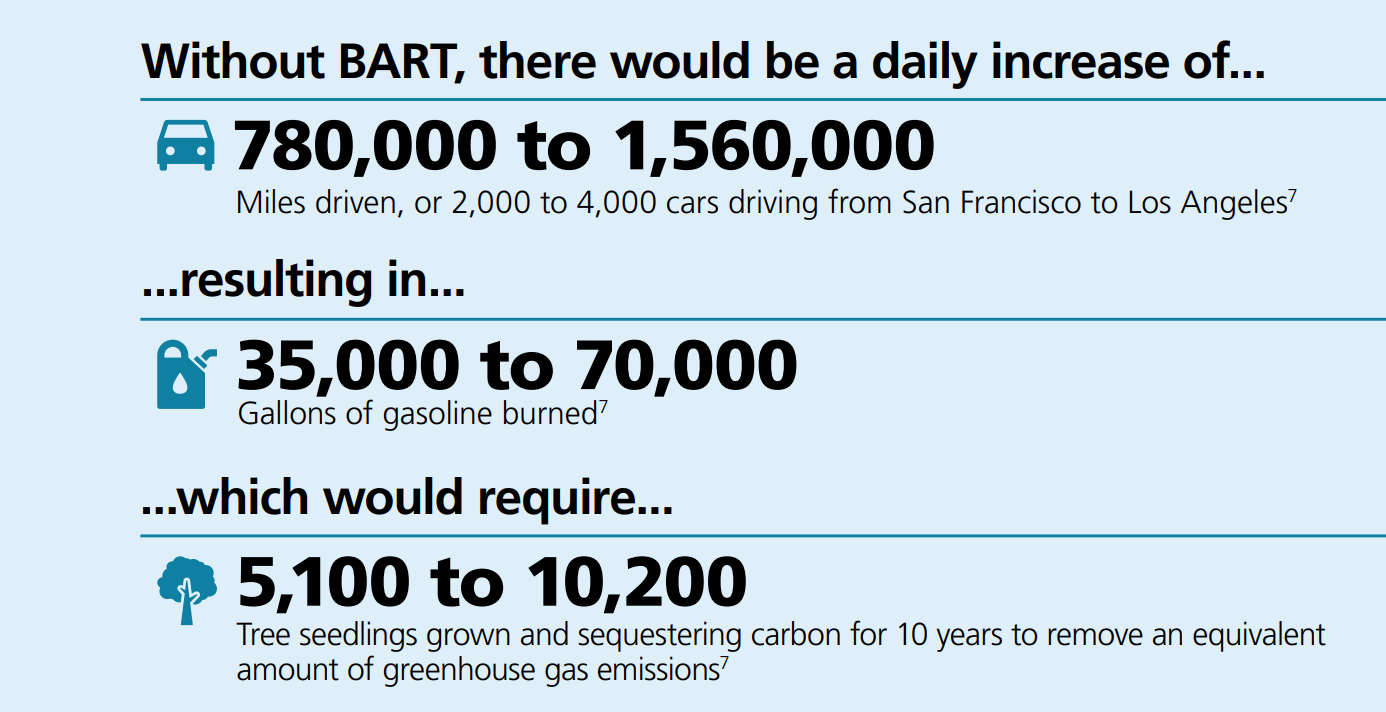
Transit is one of the greenest ways to travel, and the region and state will not meet their climate goals without a robust public transportation network. Thirty-eight percent of California’s greenhouse gas emissions come from transportation, and driving emits 42 times more greenhouse gases per mile than BART.
Taking transit also supports a healthy lifestyle. Studies have found that people who ride transit walk an additional eight to 30 minutes every day, and there is an 11% reduction in cardiovascular health risk associated with people who walk and/or bike during their commute.
III. The Future of BART
A future without BART as we know it would be disastrous. Even a reduction in BART service would have serious consequences on industry, the economy, the environment, and the millions who rely on public transportation. This future is neither sustainable nor equitable.
For more than 50 years, BART has connected Bay Area residents and visitors to their communities and life experiences, and BART is actively planning and preparing for what the coming decades may have in store, making consistent investments to improve the rider experience and modernizing infrastructure to improve service reliability.
A. The Consequences of No BART Service
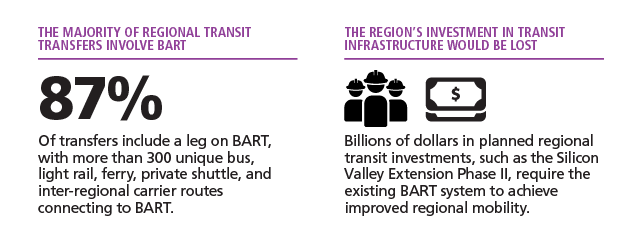
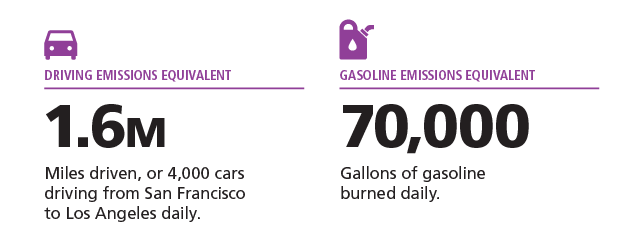
If BART stops providing service there would be significant consequences that would cascade across the regional transit network. With 87% of transit transfers including a leg on BART, all the transit services – 300 unique bus, light rail, ferry, private shuttle, and inter-regional carriers – that connect to BART would also be impacted. Further, benefits from the region’s investment in transit infrastructure, such as Silicon Valley Phase II, would not be realized if BART ceased to operate.
Without BART, mobility would become extremely limited, transportation costs would significantly increase, and thousands would be cut off from crucial quality-of-life resources, including medical offices, daycares, and educational institutions. Businesses and institutions would also lose access to their workforce, customers, students, and visitors.
Additional driving would increase greenhouse gas emissions, making it impossible to meet state and regional climate goals.
B. BART’s Stewardship of Public Resources
BART’s operating expenses have increased more slowly than the inflation rate as well as more slowly than the expenses of peer agencies (as measured by the Consumer Price Index – CPI). BART has also been a good steward of public funds and has ensured transparency through establishment of the BART Measure RR Bond Oversight Committee and the Office of the Inspector General. Funding for the latter was also recently increased.
BART is an effective and accountable public investment, and it continues to make investments to improve the rider experience, including doubling the number of train car cleanings (2022) and doubling the safety presence on trains (2023).
C. Vision for the Future
BART is ready for the future. We’re modernizing infrastructure, including installing new fare gates and upgrading the train control system; evolving service patterns to adapt to new ridership patterns; and engaging as a critical partner in the region’s vision for a seamless transit network.
As a transit provider, we are laying the groundwork for a Bay Area that is more resilient, affordable, and accessible to all.
IV. BART Connects - Rider Stories
The BART Connects storytelling series was launched in 2023 to showcase the real people who ride and rely on BART and illustrate the manifold ways the system affects their lives.
The series grew out of the Role in the Region Study, which conducted a call for stories to hear from riders and understand what BART means to them. More than 300 people responded.
We invite you to read a selection of BART Connects stories below. Find all the stories at bart.gov/bartconnects.
BART takes a second-year college student to her dream school

Read the Story
In August, Kassandra Santillan started her second year at San Francisco State University, her dream college where she studies microbiology, her dream major. If she couldn’t take BART to school, she wouldn’t be able to attend. “BART made it happen for me,” she said. “I can’t afford to live near campus, so I’d probably be at a community college instead.”
“It’s pretty crazy to be studying the field now,” she continued. “It feels unreal sometimes. I know a lot of people who don’t get this opportunity.” Sometimes, she has to remind herself: “I’m really here, and I’m really doing this thing I’ve been trying to do all my life.”
BART gave a civic architect “a sense of what was possible” for urban design

Read the Story
Howard Wong grew up riding public transportation around San Francisco. He remembers well when BART opened for service in 1972; the experience of riding the “Space Age” trains left a lasting impact on him. Around the time of the system’s opening, Wong was studying architecture and design at UC Berkeley. He said BART helped inform his “democratic sensibilities on urban design."
“No matter your class, you had a sense that you were getting special treatment when you rode the trains,” he said. “You really felt like you were a part of this democracy of benefits. You're sitting on a train with all the commuters who seemed much more affluent with their suits and ties and briefcases, but you’re right there on that train with them.”
BART has carried Elvis Herselvis to drag performances for 30 years
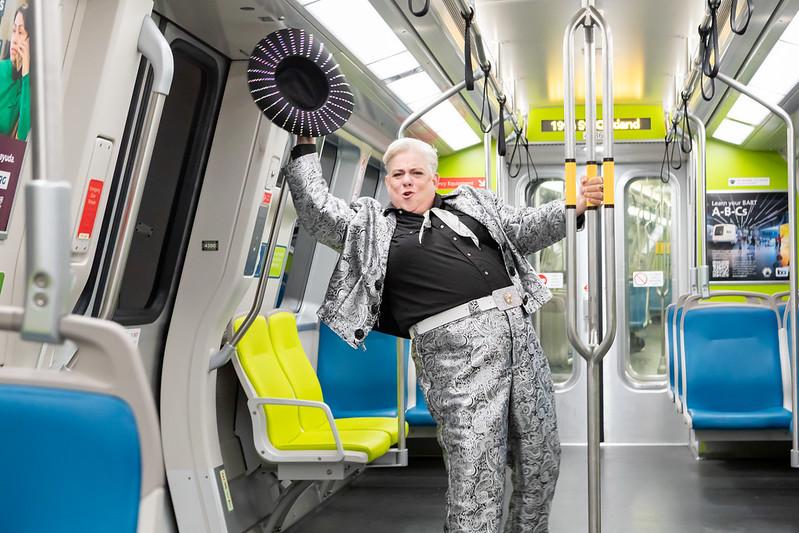
Read the Story
Elvis Presley loved his bubblegum pink Cadillac. Elvis Herselvis prefers a blue-and-white ride. Her vehicle is roomier than that Fleetwood Sixty Special, boasts twice as many wheels, and unlike that old gas guzzler, it runs on electricity.
We’ll toss her the mic so she can say it herselvis: “My life would suck without BART.”
For thirty years, Elvis Herselvis, the drag king persona of legendary drag performer, artist, and musician Leigh Crow, has taken BART to rehearsals, performances, bars, brunches, and her brother’s house in Richmond.
Unlike Mr. Presley, Crow doesn’t drive, so without BART she’s not totally sure what she’d do. Spend a lot on rideshares, probably, but that’s a cruddy option when you’re regularly traveling back and forth between San Francisco, where she typically performs, and Oakland, where she lives. About a decade ago, Crow moved to Oakland after being priced out of San Francisco. She came to the Bay Area from suburban Phoenix as a young lesbian looking for performing opportunities.
“Public transportation was one of the very attractive things about moving to San Francisco,” Crow said. “Where I grew up, you had to have a car. In the Bay, you can get where you need to go almost entirely on transit.”
A college student’s career ambitions – and romance – blossomed thanks to BART
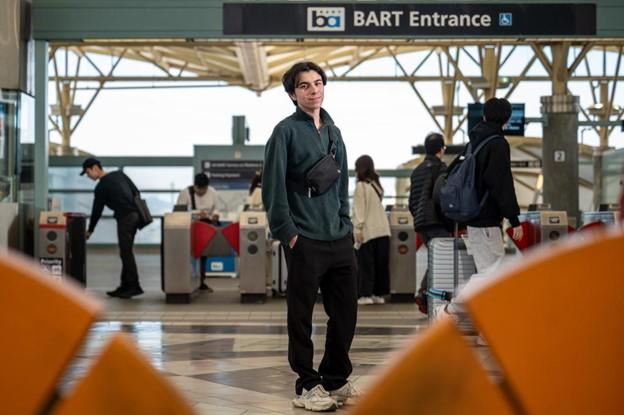
Read the Story
In just a year of riding BART, Kevin DeAntoni made a decision. When he graduates from San Francisco State in a few years, he’s going to be an urban planner specializing in transportation.
Though he grew up in the Bay Area, DeAntoni had never really used BART until 2023. He lives in Redwood City, which doesn't have a BART station, and his default mode of transportation had always been a car.
Then, DeAntoni met someone. The issue? His potential flame lived fifty miles away on the other side of the bay.
Then, he remembered Walnut Creek has a BART station, and that BART station happened to be just a short walk from his budding romantic partner's house. DeAntoni realized he could park at Millbrae Station then ride to Walnut Creek for under $8 one way -- a fare he could afford on his student budget. And so, he said to himself, "Why not? Let's try it."
A young woman from East Oakland says she "wouldn't be where I am today" without BART
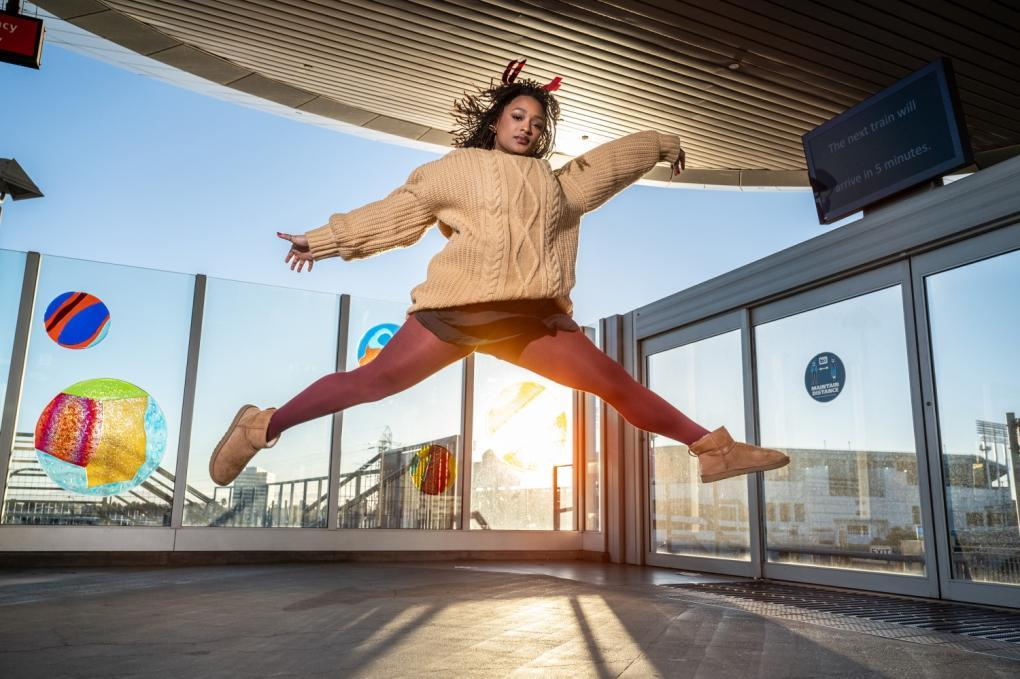
Read the Story
BART runs like a thread through every stage of Erica Mitchell’s existence. You might say the system map is a tapestry of her life, woven with memories that stretch from childhood to maturity.
Mitchell grew up in East Oakland near Coliseum Station. The trains that departed every which way from the station were “lifelines,” she said, that carried her to novel places, experiences, and possibilities.
“At different points in my life, BART has meant different things to me,” said Mitchell, now 27 and living in San Francisco. “I wouldn’t have been as independent as I was as a kid without BART; I wouldn’t have been able to survive here; and I wouldn’t be where I am today."
A transit wedding happened naturally for these newlyweds

Read the Story
Mahalia LeClerc and Benjamin Frisbey never set out to have a transit wedding. It just kind of happened that way.
“We were never like, let’s make sure we include BART in the wedding,” said Mahalia. But when she and her now-husband picked the ceremony spot – San Francisco City Hall – and then the party venue – transit-themed Line 51 Brewing Company in Jack London Square – they needed a way to get themselves and their guests from the one place to the other. Public transit simply made sense.
“We value public transit,” Mahalia said. "And though we didn’t plan it that way, our experiences using it naturally led us to having a transit wedding.”
A working mom remembers when her only downtime each day was her BART ride

Read the Story
Linda Healey commuted to San Francisco from Walnut Creek for more than twenty years. When her son was young, those daily BART rides were her only downtime in the day. “BART got me home to my child quickly,” she said. “And it got me home unstressed because I could relax, rather than sit in traffic. That was a gift.” Today, Healey’s son – now in his thirties and living in Oakland – does the same commute his mother did for so many years, though he hops on the train a few stops up the line. He even works for the same company. “I passed the BART baton to him,” Healey said. “Hopefully one day, he’ll get to take it just for fun.”
